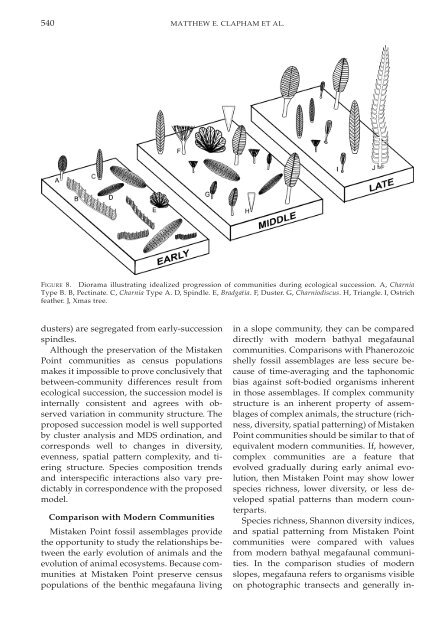Paleoecology of the oldest known animal communities: Ediacaran ...
Paleoecology of the oldest known animal communities: Ediacaran ...
Paleoecology of the oldest known animal communities: Ediacaran ...
Create successful ePaper yourself
Turn your PDF publications into a flip-book with our unique Google optimized e-Paper software.
540 MATTHEW E. CLAPHAM ET AL.<br />
FIGURE 8. Diorama illustrating idealized progression <strong>of</strong> <strong>communities</strong> during ecological succession. A, Charnia<br />
Type B. B, Pectinate. C, Charnia Type A. D, Spindle. E, Bradgatia. F, Duster. G, Charniodiscus. H, Triangle. I, Ostrich<br />
fea<strong>the</strong>r. J, Xmas tree.<br />
dusters) are segregated from early-succession<br />
spindles.<br />
Although <strong>the</strong> preservation <strong>of</strong> <strong>the</strong> Mistaken<br />
Point <strong>communities</strong> as census populations<br />
makes it impossible to prove conclusively that<br />
between-community differences result from<br />
ecological succession, <strong>the</strong> succession model is<br />
internally consistent and agrees with observed<br />
variation in community structure. The<br />
proposed succession model is well supported<br />
by cluster analysis and MDS ordination, and<br />
corresponds well to changes in diversity,<br />
evenness, spatial pattern complexity, and tiering<br />
structure. Species composition trends<br />
and interspecific interactions also vary predictably<br />
in correspondence with <strong>the</strong> proposed<br />
model.<br />
Comparison with Modern Communities<br />
Mistaken Point fossil assemblages provide<br />
<strong>the</strong> opportunity to study <strong>the</strong> relationships between<br />
<strong>the</strong> early evolution <strong>of</strong> <strong>animal</strong>s and <strong>the</strong><br />
evolution <strong>of</strong> <strong>animal</strong> ecosystems. Because <strong>communities</strong><br />
at Mistaken Point preserve census<br />
populations <strong>of</strong> <strong>the</strong> benthic megafauna living<br />
in a slope community, <strong>the</strong>y can be compared<br />
directly with modern bathyal megafaunal<br />
<strong>communities</strong>. Comparisons with Phanerozoic<br />
shelly fossil assemblages are less secure because<br />
<strong>of</strong> time-averaging and <strong>the</strong> taphonomic<br />
bias against s<strong>of</strong>t-bodied organisms inherent<br />
in those assemblages. If complex community<br />
structure is an inherent property <strong>of</strong> assemblages<br />
<strong>of</strong> complex <strong>animal</strong>s, <strong>the</strong> structure (richness,<br />
diversity, spatial patterning) <strong>of</strong> Mistaken<br />
Point <strong>communities</strong> should be similar to that <strong>of</strong><br />
equivalent modern <strong>communities</strong>. If, however,<br />
complex <strong>communities</strong> are a feature that<br />
evolved gradually during early <strong>animal</strong> evolution,<br />
<strong>the</strong>n Mistaken Point may show lower<br />
species richness, lower diversity, or less developed<br />
spatial patterns than modern counterparts.<br />
Species richness, Shannon diversity indices,<br />
and spatial patterning from Mistaken Point<br />
<strong>communities</strong> were compared with values<br />
from modern bathyal megafaunal <strong>communities</strong>.<br />
In <strong>the</strong> comparison studies <strong>of</strong> modern<br />
slopes, megafauna refers to organisms visible<br />
on photographic transects and generally in-

















